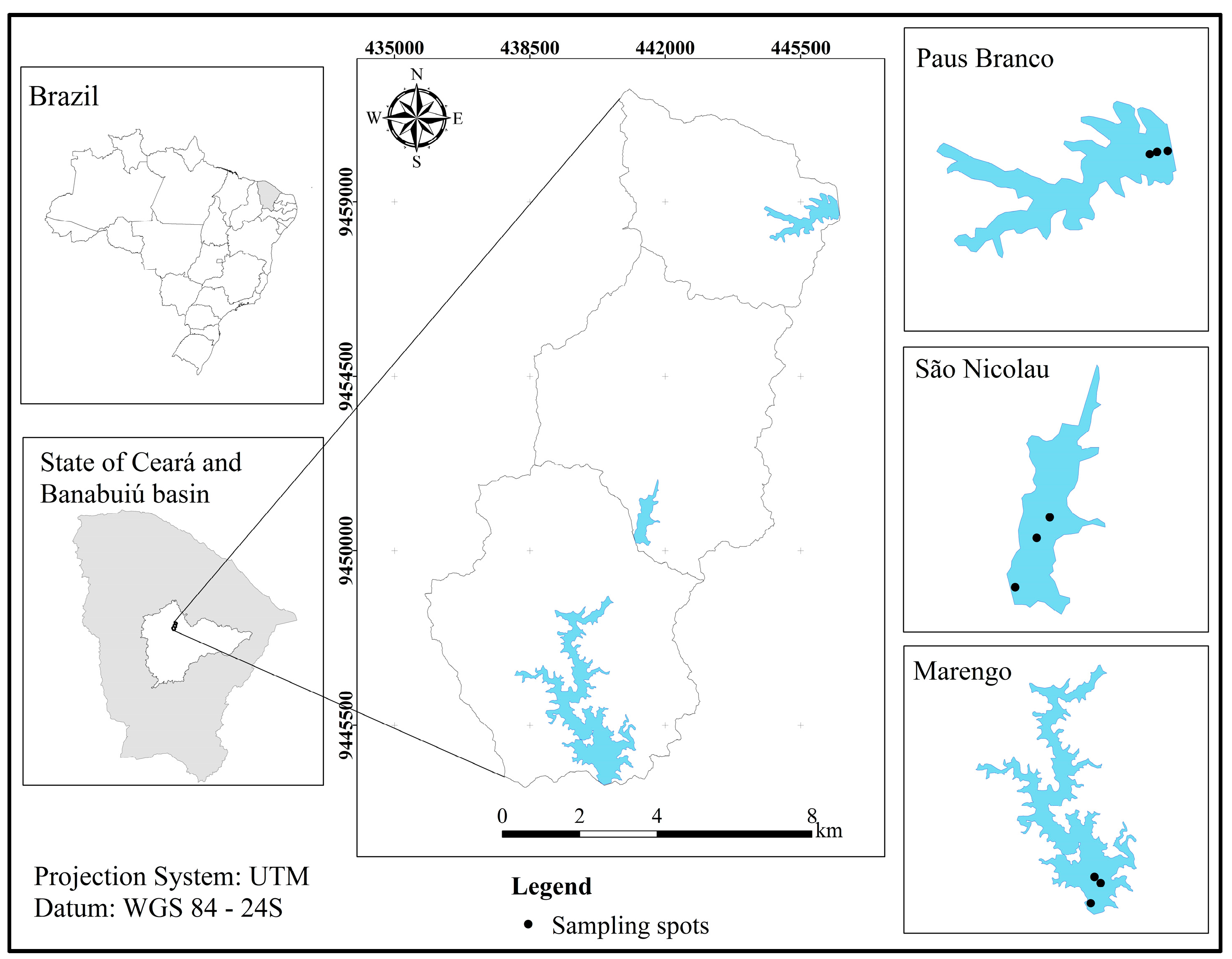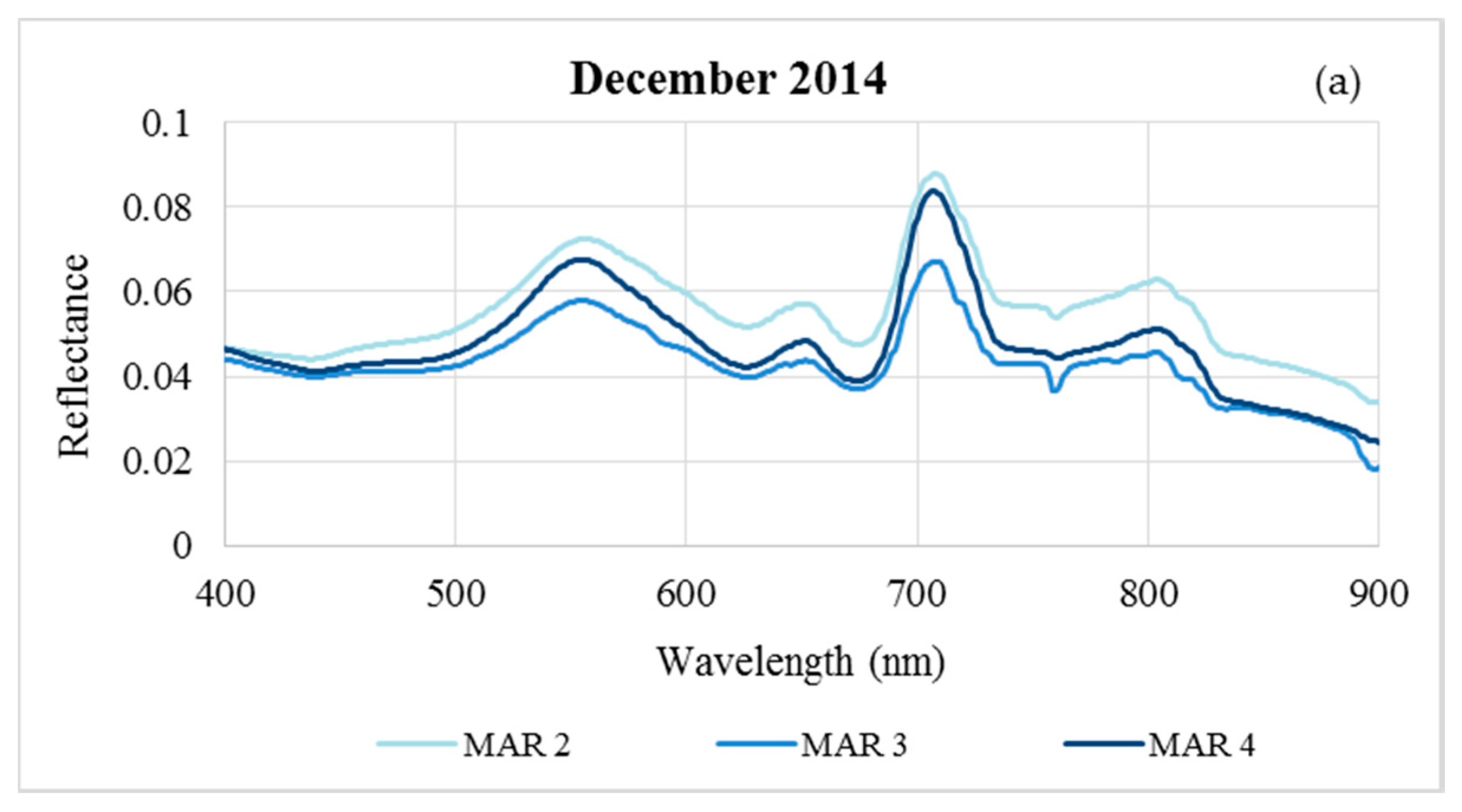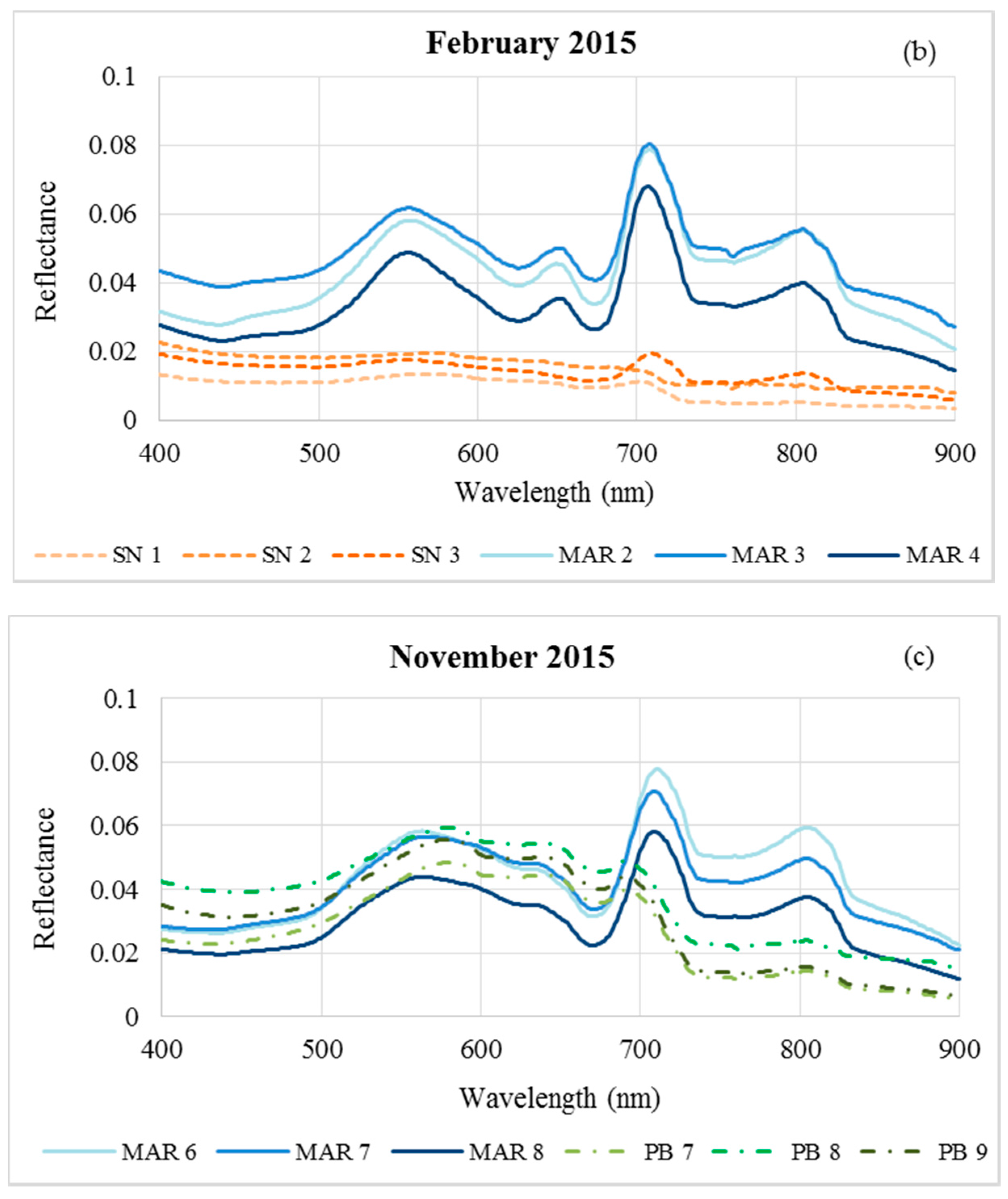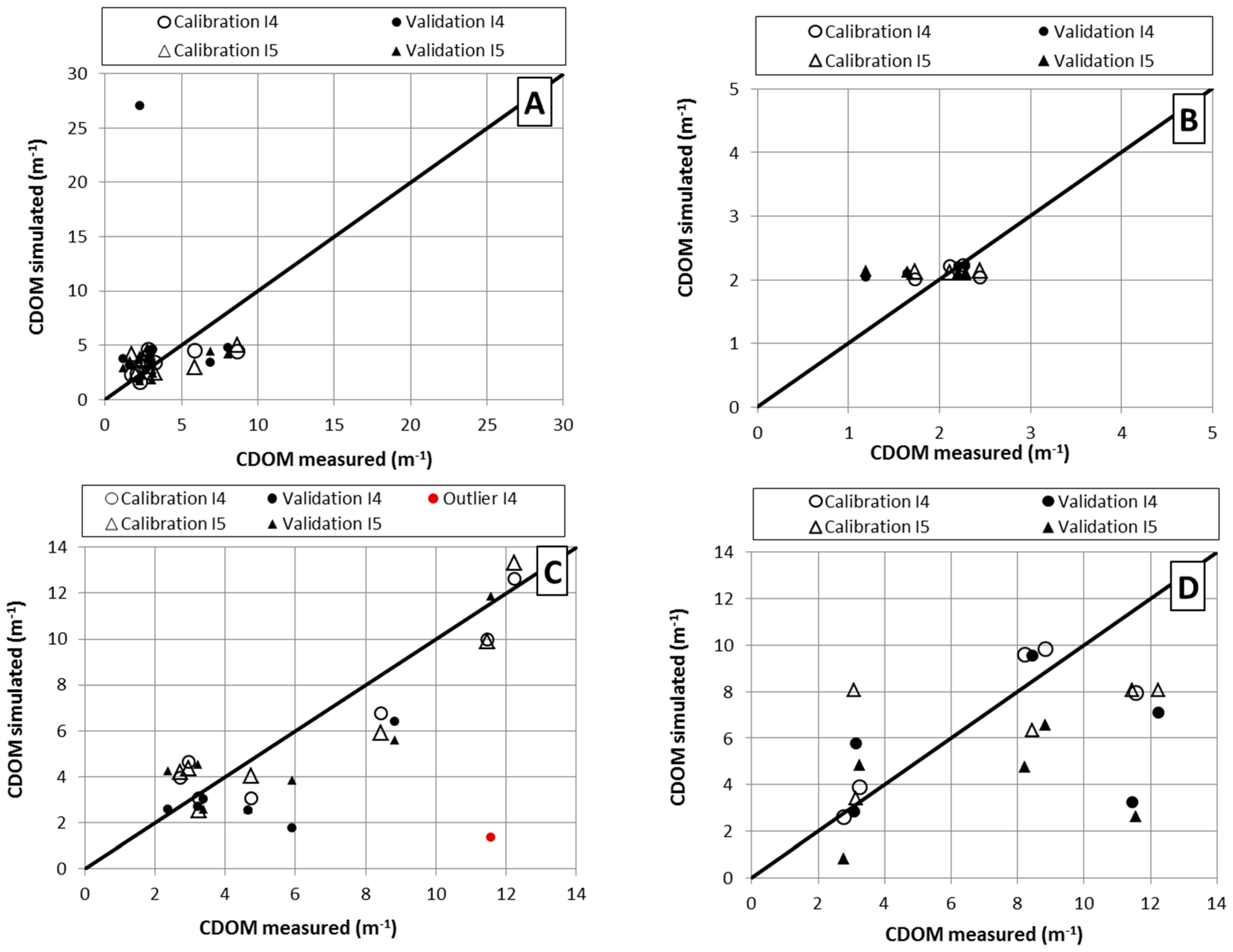In Situ and Satellite Observation of CDOM and Chlorophyll-a Dynamics in Small Water Surface Reservoirs in the Brazilian Semiarid Region
Abstract
:1. Introduction
2. Materials and Methods
2.1. Study Area
2.2. Limnological and Environmental Data
2.2.1. Hydrochemistry and Hydro-Optics
2.2.2. Calculation of the Trophic State Index
2.2.3. Environmental Data
2.3. Optical Satellite Data Processing
3. Results
3.1. Assessment of Chlorophyll-a Dynamics and Trophic State Level
3.2. Characterization of Dissolved Organic Matter
3.3. Exploratory Analysis of In Situ Reflectance Data
3.4. Satellite-Based Estimation of Chlorophyll-a and CDOM
4. Discussion
4.1. Limnological Dynamics and Trophic Conditions
4.2. Dynamics of CDOM
4.3. Bio-Optics and Remote Sensing Application
5. Conclusions
Acknowledgments
Author Contributions
Conflicts of Interest
References
- Peter, S.; de Araújo, J.C.; Araújo, N.; Herrmann, H.J. Flood avalanches in a semiarid basin with a dense reservoir network. J. Hydrol. 2014, 512, 408–420. [Google Scholar] [CrossRef]
- De Araújo, J.C. Gestão das águas de pequenos açudes na região semiárida. In Recursos Hídricos em Regiões árIdas e Semiáridas, 1st ed.; Medeiros, S.S., Gheyi, H.S., Galvão, C.O., Paz, V.P.S., Eds.; INSA: Campina Grande, Brazil, 2011; pp. 334–351. (In Portuguese) [Google Scholar]
- Heine, I.; Francke, T.; Rogass, C.; Medeiros, P.H.A.; Bronstert, A.; Foerster, S. Monitoring seasonal changes in the water surface areas of reservoirs using TerraSAR-X time series data in semiarid Northeastern Brazil. IEEE J. Sel. Top. Appl. Earth Obs. Remote Sens. 2014, 7, 3190–3199. [Google Scholar] [CrossRef]
- Toledo, C.E.; De Araújo, J.C.; Almeida, C.L. The use of remote-sensing techniques to monitor dense reservoir networks in the Brazilian semiarid region. Int. J. Remote Sens. 2014, 35, 3683–3699. [Google Scholar] [CrossRef]
- Zhang, S.; Foerster, S.; Medeiros, P.; de Araújo, J.C.; Motagh, M.; Waske, B. Bathymetric survey of water reservoirs in north-eastern Brazil based on TanDEM-X satellite data. Sci. Total Environ. 2016, 571, 575–593. [Google Scholar] [CrossRef] [PubMed]
- Brezonik, P.; Menken, K.D.; Bauer, M. Landsat-based remote sensing of lake water quality characteristics, including chlorophyll and colored dissolved organic matter (CDOM). Lake Reserv. Manag. 2009, 21, 373–382. [Google Scholar] [CrossRef]
- Dall’Olmo, G.; Gitelson, A.A. Effect of bio-optical parameter variability on the remote estimation of chlorophyll-a concentration in turbid productive waters: Experimental results. Appl. Opt. 2005, 44, 412–422. [Google Scholar] [CrossRef] [PubMed]
- Kutser, T.; Pierson, D.C.; Kallio, K.Y.; Reinart, A.; Sobek, S. Mapping lake CDOM by satellite remote sensing. Remote Sens. Environ. 2005, 94, 535–540. [Google Scholar] [CrossRef]
- Zhu, W.; Yu, Q.; Tian, Y.Q.; Becker, B.L.; Zheng, T.; Carrick, H.J. An assessment of remote sensing algorithms for colored dissolved organic matter in complex freshwater environments. Remote Sens. Environ. 2014, 140, 766–778. [Google Scholar] [CrossRef]
- Brezonik, P.L.; Olmanson, L.G.; Finlay, J.C.; Bauer, M.E. Factors affecting the measurement of CDOM by remote sensing of optically complex inland waters. Remote Sens. Environ. 2015, 157, 199–215. [Google Scholar] [CrossRef]
- Shao, T.; Song, K.; Du, J.; Zhao, Y.; Lui, Z.; Zhang, B. Retrieval of CDOM and DOC using in situ hyperspectral data: A case study for potable water in Northeast China. J. Indian Soc. Remote Sens. 2015, 44, 77–89. [Google Scholar] [CrossRef]
- Lopes, F.B.; Novo, E.M.L.M.; Barbosa, C.C.F.; Andrade, E.M.; Ferreira, R.D. Simulation of spectral bands of the MERIS sensor to estimate chlorophyll-a concentrations in a reservoir of the semi-arid region. Rev. Agro@mbiente 2016, 10, 96–106. [Google Scholar] [CrossRef]
- Olmanson, L.G.; Brezonik, P.L.; Finlay, J.C.; Bauer, M.E. Comparison of Landsat 8 and Landsat 7 for regional measurements of CDOM and water clarity in lakes. Remote Sens. Environ. 2016, 185, 119–128. [Google Scholar] [CrossRef]
- Dash, P.; Silwal, S.; Ikenga, J.O.; Pinckney, J.L.; Arslan, Z.; Lizotte, R.E. Water quality of four major lakes in Mississippi, USA: Impacts on human and aquatic ecosystem health. Water 2015, 7, 4999–5030. [Google Scholar] [CrossRef]
- Wetzel, R.G. Limnology—Lake and River Ecosystems, 3rd ed.; Academic Press: San Diego, CA, USA, 2001; pp. 805–823. ISBN 978-0-12-744760-5. [Google Scholar]
- Gholizadeh, M.H.; Melesse, A.M.; Reddi, L. A Comprehensive review on water quality parameters estimation using remote sensing techniques. Sensors 2016, 16, 1298. [Google Scholar] [CrossRef] [PubMed]
- Dekker, A.; Peters, S. The use of the Thematic Mapper for the analysis of eutrophic lakes: A case study in the Nederlands. Int. J. Remote Sens. 1993, 14, 799–821. [Google Scholar] [CrossRef]
- Tranvik, L.J. Allochthonous dissolved organic matter as an energy source for pelagic bacteria and the concept of the microbial loop. Hydrobiologia 1992, 229, 107–114. [Google Scholar] [CrossRef]
- Steinberg, E.W. Regulatory impacts of humic substances in lakes. In The Lakes Handbook—Limnology and Limnetic Ecology, 1st ed.; O’Sullivan, P.E., Reynolds, C.S., Eds.; Blackwell Science Ltd.: Malden, MA, USA, 2004; pp. 153–196. ISBN 0632047976. [Google Scholar]
- Steinberg, C.E.W.; Meinelt, T.; Timofeyev, M.A.; Bittner, M.; Menzel, R. Humic Substances (review series). Part 2: Interactions with Organisms. Environ. Sci. Pollut. Res. 2008, 15, 128–135. [Google Scholar] [CrossRef]
- Loiselle, S.A.; Bracchini, L.; Dattilo, A.M.; Ricci, M.; Tognazzi, A.; Cózar, A.; Rossi, C. Optical characterization of chromophoric dissolved organic matter using wavelength distribution of absorption spectral slopes. Limnol. Oceanogr. 2009, 54, 590–597. [Google Scholar] [CrossRef]
- Wetzel, R.G. Gradient-dominated ecosystems: Source and regulatory functions of dissolved organic matter in freshwater ecosystems. Hydrobiologia 1992, 229, 181–198. [Google Scholar] [CrossRef]
- Pflugmacher, S.; Spangenberg, M.; Steinberg, C.E.W. Dissolved Organic Matter (DOM) and the effects on the aquatic macrophyte Ceratophyllum demersum in relation to photosynthesis, pigment pattern and activity of detoxication enzymes. J. Appl. Bot. 1999, 73, 184–190. [Google Scholar]
- Farjalla, V.F.; Amado, A.M.; Suhett, A.L.; Meirelles-Pereira, F. DOC removal paradigms in highly humic aquatic ecosystems. Environ. Sci. Pollut. Res. 2009, 16, 531–553. [Google Scholar] [CrossRef] [PubMed]
- Zhang, Y.; van Dijk, M.A.; Lui, M.; Zhu, G.; Qin, B. The contribution of phytoplankton degradation to chromophoric dissolved organic matter (CDOM) in eutrophic shallow lakes: Field and experimental evidence. Water Res. 2009, 43, 4685–4697. [Google Scholar] [CrossRef] [PubMed]
- Helms, J.R.; Stubbins, A.; Ritchie, J.D.; Minor, E.C.; Kieber, D.J.; Mopper, K. Absorption spectral slopes and slope ratios as indicators of molecular weight, source and photobleaching of chromophoric dissolved organic matter. Limnol. Oceanogr. 2008, 53, 955–969. [Google Scholar] [CrossRef]
- Bittar, T.; Vieira, A.A.H.; Stubbins, A.; Mopper, K. Competition between photochemical and biological degradation of dissolved organic matter from the cyanobacteria Microcystis aeruginosa. Limnol. Oceanogr. 2015, 60, 1172–1194. [Google Scholar] [CrossRef]
- Hansen, A.M.; Kraus, T.E.C.; Pellerin, B.A.; Fleck, J.A.; Downing, B.D.; Bergamaschi, B.A. Optical properties of dissolved organic matter (DOM): Effects of biological and photolytic degradation. Limnol. Oceanogr. 2016, 61, 1015–1032. [Google Scholar] [CrossRef]
- Kutser, T.; Verpoorter, C.; Paavel, B.; Tranvik, L.J. Estimating lake carbon fractions from remote sensing data. Remote Sens. Environ. 2015, 157, 138–146. [Google Scholar] [CrossRef]
- Shi, L.; Mao, Z.; Wu, J.; Liu, M.; Zhang, Y.; Wang, Z. Variations in spectral absorption properties of phytoplankton, non-algal particles and chromophoric dissolved organic matter in Lake Qiandaohu. Water 2017, 9, 352. [Google Scholar] [CrossRef]
- Palmer, S.C.J.; Kutser, T.; Hunter, P.D. Remote sensing of inland waters: Challenges, progress and future directions. Remote Sens. Environ. 2015, 157, 1–8. [Google Scholar] [CrossRef]
- Chaves, F.I.B.; Lima, P.F.; Leitão, R.C.; Paulino, W.D.; Santaella, S.T. Influence of rainfall on the trophic status of a Brazilian semiarid reservoir. Acta Sci. 2013, 35, 505–511. [Google Scholar] [CrossRef]
- De Freitas Lima, P.; Sousa, M.S.R.; Porfírio, A.F.; Almeida, B.S.; Freire, R.H.F.; Santaella, S.T. Preliminary analysis on the use of Trophic State Indexes in a Brazilian semiarid reservoir. Acta Sci. 2015, 37, 309–318. [Google Scholar] [CrossRef]
- Wiegand, M.C.; Piedra, J.I.G.; De Araújo, J.C. Vulnerability towards eutrophication of two tropical lakes in both humid (Cuba) and semiarid (Brazil) climates. Eng. Sanit. Ambient. 2016, 21, 415–424. [Google Scholar] [CrossRef]
- Figueirêdo, M.C.B.; Teixeira, A.S.; Araújo, L.F.P.; Rosa, M.F.; Paulino, W.D.; Mota, S.; de Araújo, J.C. Avaliação da vulnerabilidade ambiental de reservatórios à eutrofização. Eng. Sanit. Ambient. 2007, 12, 399–409. (In Portuguese) [Google Scholar] [CrossRef]
- Santos, J.C.N.; Andrade, E.M.; Neto, J.R.A.; Meireles, A.C.M.; Palácio, H.A.Q. Land use and trophic state dynamics in a tropical semiarid reservoir. Rev. Ciênc. Agron. 2014, 45, 35–44. [Google Scholar] [CrossRef]
- Carlson, R.E. A trophic state index for lakes. Limnol. Oceanogr. 1977, 22, 361–380. [Google Scholar] [CrossRef]
- Toledo, A.P., Jr. Informe Preliminar Sobre os Estudos para Obtenção de um Índice para Avaliação Simplificada do Estado Trófico de Reservatórios de Regiões Quentes Tropicais; Report in Portuguese; Companhia Ambiental do Estado de São Paulo (CETESB): São Paulo, Brazil, 1990. (In Portuguese)
- Salas, H.J.; Martino, P. A simplified phosphorus trophic state model for warm—Water tropical lakes. Water Res. 1991, 25, 341–350. [Google Scholar] [CrossRef]
- Li, S.; Bush, R.T.; Mao, R.; Xiong, L.; Ye, C. Extreme drought causes distinct water acidification and eutrophication in the Lower Lakes (Lakes Alexandrina and Albert), Australia. J. Hydrol. 2017, 544, 133–146. [Google Scholar] [CrossRef]
- Münster, U. Studies on phosphatase activities in humic lakes. Environ. Int. 1994, 20, 49–59. [Google Scholar] [CrossRef]
- Carpenter, S.R.; Pace, M.L. Dystrophy and eutrophy in lake ecosystems: Implications of fluctuating inputs. Oikos 1997, 78, 3–14. [Google Scholar] [CrossRef]
- De Araújo, J.C.; Bronstert, A. A method to assess hydrological drought in semiarid environments and its application to the Jaguaribe River basin, Brazil. Water Int. 2015, 41, 213–230. [Google Scholar] [CrossRef]
- Milton, E.J. Principles of field spectroscopy. Int. J. Remote Sens. 1987, 8, 1807–1827. [Google Scholar] [CrossRef]
- American Public Health Association (APHA). Standard Methods for the Examination of Water and Wastewater, 21st ed.; American Public Health Association: Washington, DC, USA, 2005. [Google Scholar]
- Bricaud, A.; Morel, A.; Prieur, L. Absorption by dissolved organic matter of the sea (yellow substance) in the UV and visible domains. Limnol. Oceanogr. 1981, 26, 43–53. [Google Scholar] [CrossRef]
- Fundação Cearense de Meteorologia e Recursos Hídricos (FUNCEME). Dados de Pluviometria do Estado do Ceará. Available online: http://www.funceme.br/app/calendario/produto/municipios/media/mensal (accessed on 7 February 2017). (In Portuguese).
- Roy, D.P.; Wulder, M.A.; Loveland, T.R.; Woodcock, C.E.; Allen, R.G.; Anderson, M.C.; Helder, D.; Irons, J.R.; Johnson, D.M.; Kennedy, R. Landsat-8: Science and product vision for terrestrial global change research. Remote Sens. Environ. 2014, 145, 154–172. [Google Scholar] [CrossRef]
- RapidEye—Satellite Imagery Product Specifications, Version 6.1, April 2015. Available online: http://blackbridge.com/rapideye/upload/RE_Product_Specifications_ENG.pdf (accessed on 18 August 2015).
- Weichelt, H.; Rosso, P.; Marx, A.; Reigber, S.; Douglas, K.; Heynen, M. The RapidEye Red Edge Band. Available online: https://resa.blackbridge.com/files/2014-06/Red_Edge_White_Paper.pdf (accessed on 30 August 2015).
- USGS. Provisional Landsat 8 Surface Reflectance Data; U.S. Geological Survey: Sioux Falls, SD, USA, 2015. Available online: http://landsat.usgs.gov/about_LU_Special_Issue_3.php (accessed on 1 August 2016).
- Richter, R.; Schläpfer, D. Atmospheric/Topographic Correction for Satellite Imagery. ATCOR 2/3 User Guide. Available online: http://www.rese.ch/pdf/atcor3_manual.pdf (accessed on 9 January 2016).
- Nash, J.E.; Sutcliffe, J.V. River flow forecasting through conceptual models part I—A discussion of principles. J. Hydrol. 1970, 10, 282–290. [Google Scholar] [CrossRef]
- Moriasi, D.N.; Arnold, J.G.; Van Liew, M.W.; Bingner, R.L.; Harmel, R.D.; Veith, T.L. Model evaluation guidelines for systematic quantification of accuracy in watershed simulations. Am. Soc. Agric. Biol. Eng. 2007, 50, 885–900. [Google Scholar]
- Conselho Nacional do Meio Ambiente (CONAMA). Available online: http://www.mma.gov.br/port/conama/res/res05/res35705.pdf (accessed on 6 June 2014).
- Braga, G.G.; Becker, V.; Oliveira, J.N.P.; Mendonça Júnior, J.R.; Bezerra, A.F.M.; Torres, L.M.; Galvão, A.M.F.; Mattos, A. Influence of extended drought on water quality in tropical reservoirs in a semiarid region. Acta Limnol. Bras. 2015, 27, 15–23. [Google Scholar] [CrossRef]
- Bornette, G.; Puijaloné, S. Response of aquatic plants to abiotic factors: A review. Aquat. Sci. 2011, 73, 1–14. [Google Scholar] [CrossRef]
- Pełechaty, M.; Pronin, E.; Pukacz, A. Charophyte occurrence in Ceratophyllum demersum stands. Hydrobiologia 2014, 737, 111–120. [Google Scholar] [CrossRef]
- Reche, I.; Pace, M.L.; Cole, J.J. Relationship of trophic and chemical conditions to photobleaching of dissolved organic matter in lake ecosystems. Biogeochemistry 1999, 44, 258–289. [Google Scholar] [CrossRef]
- Watanabe, F.S.Y.; Alcântara, E.; Rodrigues, T.W.P.; Imai, N.N.; Barbosa, C.C.F.; Rotta, L.H.S. Estimation of Chlorophyll-a concentration and the trophic state of the Barra Bonita Hydroelectric Reservoir using OLI/Landsat-8 images. Int. J. Environ. Res. Public Health 2015, 12, 10391–10417. [Google Scholar] [CrossRef] [PubMed]
- Alcântara, E.; Bernardo, N.; Watanabe, F.; Rodrigues, T.; Rotta, L.; Carmo, A.; Shimabukuro, M.; Gonçalves, S.; Imai, N. Estimating the CDOM absorption coefficient in tropical inland waters using OLI/Landsat-8 images. Remote Sens. Lett. 2016, 7, 661–670. [Google Scholar] [CrossRef]
- Del Vecchio, R.; Blough, N. Photobleaching of chromophoric dissolved organic matter in natural waters: Kinetics and modeling. Mar. Chem. 2002, 78, 231–253. [Google Scholar] [CrossRef]
- Spencer, R.G.M.; Butler, K.D.; Aiken, G.R. Dissolved organic carbon and chromophoric dissolved organic matter properties of rivers in the USA. J. Geophys. Res. 2012, 117, 1–14. [Google Scholar] [CrossRef]
- Brandão, L.P.M.; Staehr, P.A.; Bezerra-Neto, J.F. Seasonal changes in the optical properties of two contrasting tropical freshwater systems. J. Limnol. 2016, 75, 508–551. [Google Scholar] [CrossRef]
- Menken, K.D.; Brezonik, P.L.; Bauer, M.E. Influence of chlorophyll and colored dissolved organic matter (CDOM) on lake reflectance spectra: Implications for measuring lake properties by remote sensing. Lake Reserv. Manag. 2006, 22, 179–190. [Google Scholar] [CrossRef]
- Hansen, C.H.; Burian, S.J.; Dennison, P.E.; Williams, G.P. Spatiotemporal variability of lake water quality in the context of remote Sensing models. Remote Sens. 2017, 9, 409. [Google Scholar] [CrossRef]








| FIELD SAMPLING DATE | SATELLITE PRODUCT | ||||||
|---|---|---|---|---|---|---|---|
| OLI/Landsat-8 | REIS/RapidEye | ||||||
| Acquisition Date | Time Interval (days) | Cloud Cover (%) | Acquisition Date | Time Interval (days) | Cloud Cover (%) | ||
| 31 May 2014 | 2 June 2014 | 2 | 9.8 | 9 June 2014 | 10 | 15 (N)/20 (S) | |
| 2 July 2014 | N.A. | N.A. | |||||
| 2 August 2014 | 5 August 2014 | 3 | 3.4 | 5 August 2014 | 3 | 0.3 (N)/0.9 (S) | |
| 30 August 2014 | N.A. | N.A. | |||||
| 27 September 2014 | 22 September 2014 | 5 | 12.5 | N.A. | |||
| 31 October 2014 | N.A. | 16 October 2014 | 15 | 4.4 (N)/4.7 (S) | |||
| 29 November 2014 | N.A. | 7 December 2014 | 8 | 5 (N), 17 (S) | |||
| 27 December 2014 | N.A. | N.A. | |||||
| 3 February 2015 | 28 January 2015 | 6 | 8.8 | N.A. | |||
| 13 March 2015 | N.A. | N.A. | |||||
| 18 April 2015 | N.A. | N.A. | |||||
| 23 May 2015 | N.A. | N.A. | |||||
| 19 June 2015 | N.A. | 18 June 2015 | 1 | 0 (N), 2 (S) | |||
| 3 September 2015 | 24 August 2015 | 9 | <1 | 7 September 2015 | 4 | 2 (N) | |
| 11 November 2015 | 12 November 2015 | 1 | 16.7 | N.A. | |||
| 13 January 2016 | N.A. | N.A. | |||||
| Attributes | Statistic | Marengo | Paus Branco | São Nicolau | |||
|---|---|---|---|---|---|---|---|
| Rainy | Dry | Rainy | Dry | Rainy | Dry | ||
| Secchi Disk (m) | n | n = 22 | n = 31 | n = 14 | n = 21 | n = 17 | n = 23 |
| Min-Max | 0.1–0.3 | 0.1–0.3 | 0.3–1.5 | 0.4–1.1 | 0.4–1.5 | 0.2–1.5 | |
| Mean ± SD | 0.18 ± 0.06 | 0.2 ± 0.07 | 0.9 ± 0.3 | 0.7 ± 0.1 | 1.0 ± 0.4 | 0.95 ± 0.4 | |
| T.S.S. (mg·L−1) | n | n = 18 | n = 12 | n = 14 | n = 12 | n = 15 | n = 8 |
| Min-Max | 28.2–90.5 | 27.8–77.8 | 2.3–129.0 | 3.6–14 | 0.4–26 | 1.2–101.3 | |
| Mean ± SD | 47.8 ± 12.6 | 51.4 ± 12.3 | 20.0 ± 23.3 | 7.7 ± 3.4 | 6.0 ± 6.1 | 23.7 ± 30.3 | |
| Chl-a (µg·L−1) | n | n = 22 | n = 27 | n = 14 | n = 14 | n = 15 | n = 22 |
| Min-Max | 28.2–90.5 | 20.2–263.0 | <1–41.0 | <1–34.7 | <1–25.0 | <1–23.2 | |
| Mean ± SD | 158.2 ± 79.0 | 80.2 ± 42.1 | 8.9 ± 10.1 | 10.6 ± 10.5 | 5.7 ± 7.2 | 2.5 ± 3.8 | |
| TP (mg·m−3) | n | n = 22 | n = 31 | n = 12 | n = 27 | n = 18 | n = 23 |
| Min-Max | 161.1–571.1 | 101–1130 | 28–236.4 | 25–501 | 218–666 | 204–2851 | |
| Mean ± SD | 248.2 ± 80.2 | 266 ± 174 | 102.4 ± 49 | 145 ± 97 | 376 ± 104 | 527 ± 234 | |
| PO43− (mg·m−3) | n | n = 22 | n = 24 | n = 12 | n = 18 | n = 18 | n = 20 |
| Min-Max | 0.0–0.1 | 0.0–0.2 | 0.0–0.1 | 0.0–0.2 | 0.1–0.4 | 0.2–2.8 | |
| Mean ± SD | 0.0 ± 0.0 | 0.1 ± 0.1 | 0.0 ± 0.0 | 0.1 ± 0.1 | 0.2 ± 0.1 | 0.4 ± 0.2 | |
| aCDOM(440) (m−1) | n | n = 19 | n = 22 | n = 8 | n = 13 | n = 15 | n = 18 |
| Min-Max | 2.1–13.0 | 0.4–8.7 | 1.1–5.1 | 2.4–7.3 | 0.9–12.2 | 3.1–9.9 | |
| Mean ± SD | 4.1 ± 2.2 | 3.3 ± 1.5 | 3.0 ± 0.6 | 4.1 ± 1.0 | 4.5 ± 2.9 | 6.7 ± 1.9 | |
| Attribute: Chlorophyll-a (µg·L−1) | ||||
| OLI/Landsat-8 | REIS/RapidEye | OLI/Landsat-8 | REIS/RapidEye | |
| Index I1 = [(2 × Green)/(Blue + Red)] | Index I2 = (Blue/NIR) | Index I3 = NIR | ||
| PR | Chl = −74.33 × I1 + 170.09 | Chl = 96.52 × I1−1.66 | Chl = −90.12 × I2 + 137.12 | Chl = 848.9 × I3 − 6.62 |
| NPR | Chl = 0.07 × I14.55 | Chl = 1.2 × I11.15 | Chl = 0.02e3.02 × I2 | Chl = 74.07 × I3 − 0.36 |
| All | Chl = 0.27 × I111.76 | Chl= 3.89 × I11.0 | Chl = 14.70 × I22.94 | Chl= 11951 × I32.46 |
| Attribute: CDOM (m−1) | ||||
| OLI/Landsat-8 | REIS/RapidEye | OLI/Landsat-8 | REIS/RapidEye | |
| Index I4 = (Blue/Red) | Index I5 = Green | |||
| PR | CDOM = 8.04 × I4x2.65 | CDOM = 2.25 × I40.02 | CDOM = 89.82 × I5 − 0.54 | CDOM = 2.03 × I5−0.01 |
| NPR | CDOM = 11.03 × I45.07 | CDOM = 2.86 × I4−0.30 | CDOM = 0.5437 × I5−0.56 | CDOM = 9.12e−12 × I5 |
| All | CDOM = 0.16e4.09 × I4 | CDOM = −0.06 × I4 + 0.64 | CDOM = 0.59 × I5−0.53 | CDOM = 0.80 × I5−0.24 |
| Attribute | Chlorophyll-a | CDOM | ||||||
|---|---|---|---|---|---|---|---|---|
| L8 | RE | L8 | RE | L8 | RE | L8 | RE | |
| I1 | I1 | I2 | I3 | I4 | I4 | I5 | I5 | |
| r, all reservoirs | 0.10 | −0.23 | −0.50 | 0.84 | 0.23 | 0.22 | −0.47 | −0.57 |
| R2, PR reservoir | 0.12 | 0.24 | 0.13 | 0.66 | 0.50 | 0.13 | 0.15 | 0.00 |
| R2, NPR reservoirs | 0.14 | 0.54 | 0.38 | 0.29 | 0.75 | 0.10 | 0.77 | 0.29 |
| R2, all reservoirs | 0.28 | 0.20 | 0.13 | 0.40 | 0.69 | 0.25 | 0.48 | 0.65 |
| NSE, PR reservoir | −0.21 | 0.15 | 0.15 | 0.62 | −13.54 | −0.15 | 0,25 | −0.47 |
| NSE, NPR reservoirs | −0.18 | −0.32 | −0.16 | 0.15 | 0.17 | −0.32 | 0.89 | −0.79 |
| NSE, all reservoirs | −3.89 | −0.40 | −0.45 | 0.71 | −80.28 | −1.18 | 0.38 | 0.28 |
| RMR, PR reservoir | 1.05 | 0.85 | 0.87 | 0.57 | 0.73 | 0.93 | 0.81 | 3.58 |
| RMR, NPR reservoirs | 1.02 | 1.06 | 1.01 | 0.85 | 1.29 | 1.03 | 0.56 | 1.20 |
| RMR, all reservoirs | 2.15 | 1.14 | 1.17 | 0.52 | 8.73 | 1.39 | 0.76 | 0.80 |
| PBIAS, PR reservoir | 0.12 | 0.43 | 0.31 | 0.24 | 0.80 | −0.17 | 0.12 | 0.98 |
| PBIAS, NPR reservoirs | 0.93 | 0.51 | 0.94 | 0.66 | 0.49 | 0.26 | 0.09 | 0.43 |
| PBIAS, all reservoirs | 0.12 | 0.90 | 0.78 | 0.24 | −1.24 | 0.88 | 0.12 | 0.28 |
© 2017 by the authors. Licensee MDPI, Basel, Switzerland. This article is an open access article distributed under the terms and conditions of the Creative Commons Attribution (CC BY) license (http://creativecommons.org/licenses/by/4.0/).
Share and Cite
Coelho, C.; Heim, B.; Foerster, S.; Brosinsky, A.; De Araújo, J.C. In Situ and Satellite Observation of CDOM and Chlorophyll-a Dynamics in Small Water Surface Reservoirs in the Brazilian Semiarid Region. Water 2017, 9, 913. https://doi.org/10.3390/w9120913
Coelho C, Heim B, Foerster S, Brosinsky A, De Araújo JC. In Situ and Satellite Observation of CDOM and Chlorophyll-a Dynamics in Small Water Surface Reservoirs in the Brazilian Semiarid Region. Water. 2017; 9(12):913. https://doi.org/10.3390/w9120913
Chicago/Turabian StyleCoelho, Christine, Birgit Heim, Saskia Foerster, Arlena Brosinsky, and José Carlos De Araújo. 2017. "In Situ and Satellite Observation of CDOM and Chlorophyll-a Dynamics in Small Water Surface Reservoirs in the Brazilian Semiarid Region" Water 9, no. 12: 913. https://doi.org/10.3390/w9120913





